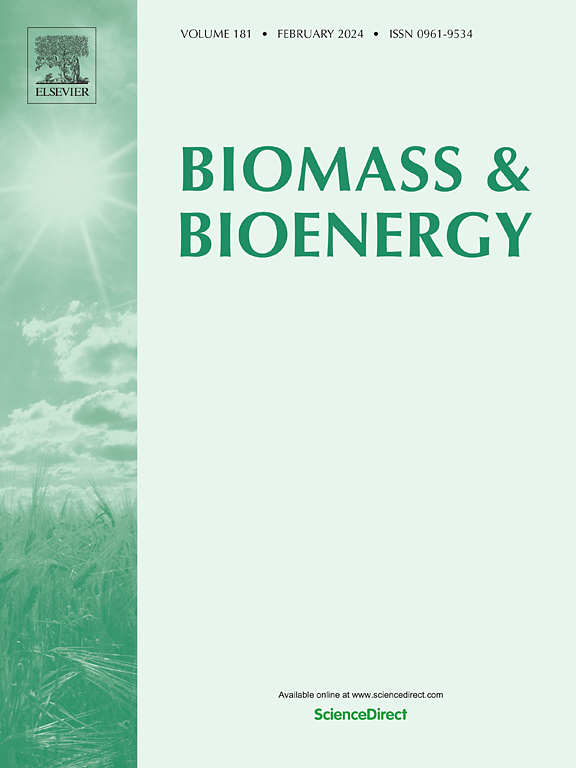Unveiling the efficacy of TiO2-mediated calcareous nanocatalyst towards cost-effective biodiesel synthesis
IF 5.8
2区 生物学
Q1 AGRICULTURAL ENGINEERING
引用次数: 0
Abstract
The global energy matrix, predominantly fuelled by fossil sources constituting 85 % of consumption, confronts critical ecological ramifications, including prodigious greenhouse gas emissions precipitating climate change and pervasive pollution. This probe elucidates the mechanistic proficiency and economic viability of TiO2-augmented CaO-derived nano-catalysts for biodiesel production from Brassica napus oil. Synthesized via sol-gel techniques with variable precursor concentrations and calcination temperatures, these nano-catalysts were rigorously characterized using UV spectroscopy, FTIR, SEM, XRD, zeta potential, EDAX, and particle size analysis. The utmost biodiesel yield of 95.87 % was attained utilizing response surface methodology under a 2.25-h reaction interval with a 5 % catalyst weight, a 1:12 oil-to-methanol ratio, and a temperature of 60 °C. Thermodynamic and kinetic examinations revealed the transesterification reaction to be endothermic following pseudo-first-order kinetics. The catalyst exhibited notable reusability, maintaining a conversion efficiency of 76.86 % after five consecutive cycles. The characteristics of the produced biodiesel met the required standards, with production costs calculated at $0.78 per litre and $7.0 per kilogram of TiO2-CaO catalyst, underscoring its economic feasibility. This research accentuates the TiO2-CaO nanocatalyst's potential in mitigating the environmental and economic detriments associated with fossil fuel dependency. Finally, the study provided future perspectives by identifying gaps highlighted in recent bibliometric analyses of the reported research.

揭示二氧化钛介导的钙质纳米催化剂在低成本生物柴油合成中的作用
全球能源矩阵主要由化石能源驱动,占消费总量的85%,面临着严重的生态后果,包括巨大的温室气体排放导致气候变化和无处不在的污染。本研究阐明了以甘蓝型油菜油为原料制备生物柴油的二氧化钛增强氧化钙衍生纳米催化剂的机理熟练度和经济可行性。这些纳米催化剂采用溶胶-凝胶技术在不同的前驱体浓度和煅烧温度下合成,并通过UV光谱、FTIR、SEM、XRD、zeta电位、EDAX和粒度分析对其进行了严格的表征。在反应时间为2.25 h、催化剂质量为5%、油甲醇比为1:12、反应温度为60℃的条件下,采用响应面法得到的生物柴油产率最高为95.87%。热力学和动力学测试表明,酯交换反应是吸热反应,符合准一级动力学。该催化剂具有明显的可重复使用性,连续循环5次后转化率仍保持在76.86%。生产的生物柴油性能达到要求标准,生产成本为每升0.78美元,TiO2-CaO催化剂成本为每公斤7.0美元,经济可行性强。这项研究强调了TiO2-CaO纳米催化剂在减轻与化石燃料依赖相关的环境和经济损害方面的潜力。最后,该研究通过确定最近文献计量分析报告中突出的差距,提供了未来的前景。
本文章由计算机程序翻译,如有差异,请以英文原文为准。
求助全文
约1分钟内获得全文
求助全文
来源期刊

Biomass & Bioenergy
工程技术-能源与燃料
CiteScore
11.50
自引率
3.30%
发文量
258
审稿时长
60 days
期刊介绍:
Biomass & Bioenergy is an international journal publishing original research papers and short communications, review articles and case studies on biological resources, chemical and biological processes, and biomass products for new renewable sources of energy and materials.
The scope of the journal extends to the environmental, management and economic aspects of biomass and bioenergy.
Key areas covered by the journal:
• Biomass: sources, energy crop production processes, genetic improvements, composition. Please note that research on these biomass subjects must be linked directly to bioenergy generation.
• Biological Residues: residues/rests from agricultural production, forestry and plantations (palm, sugar etc), processing industries, and municipal sources (MSW). Papers on the use of biomass residues through innovative processes/technological novelty and/or consideration of feedstock/system sustainability (or unsustainability) are welcomed. However waste treatment processes and pollution control or mitigation which are only tangentially related to bioenergy are not in the scope of the journal, as they are more suited to publications in the environmental arena. Papers that describe conventional waste streams (ie well described in existing literature) that do not empirically address ''new'' added value from the process are not suitable for submission to the journal.
• Bioenergy Processes: fermentations, thermochemical conversions, liquid and gaseous fuels, and petrochemical substitutes
• Bioenergy Utilization: direct combustion, gasification, electricity production, chemical processes, and by-product remediation
• Biomass and the Environment: carbon cycle, the net energy efficiency of bioenergy systems, assessment of sustainability, and biodiversity issues.
 求助内容:
求助内容: 应助结果提醒方式:
应助结果提醒方式:


